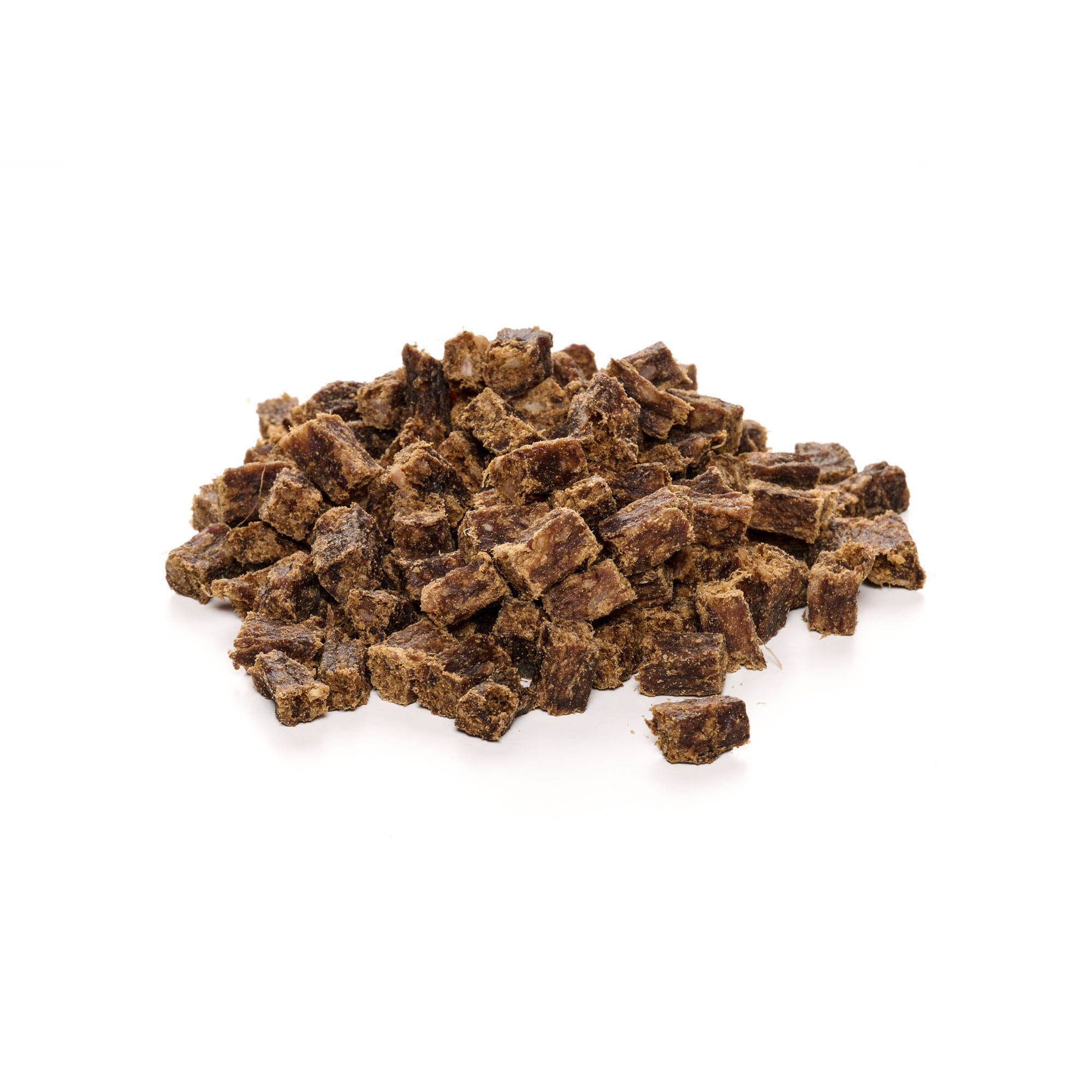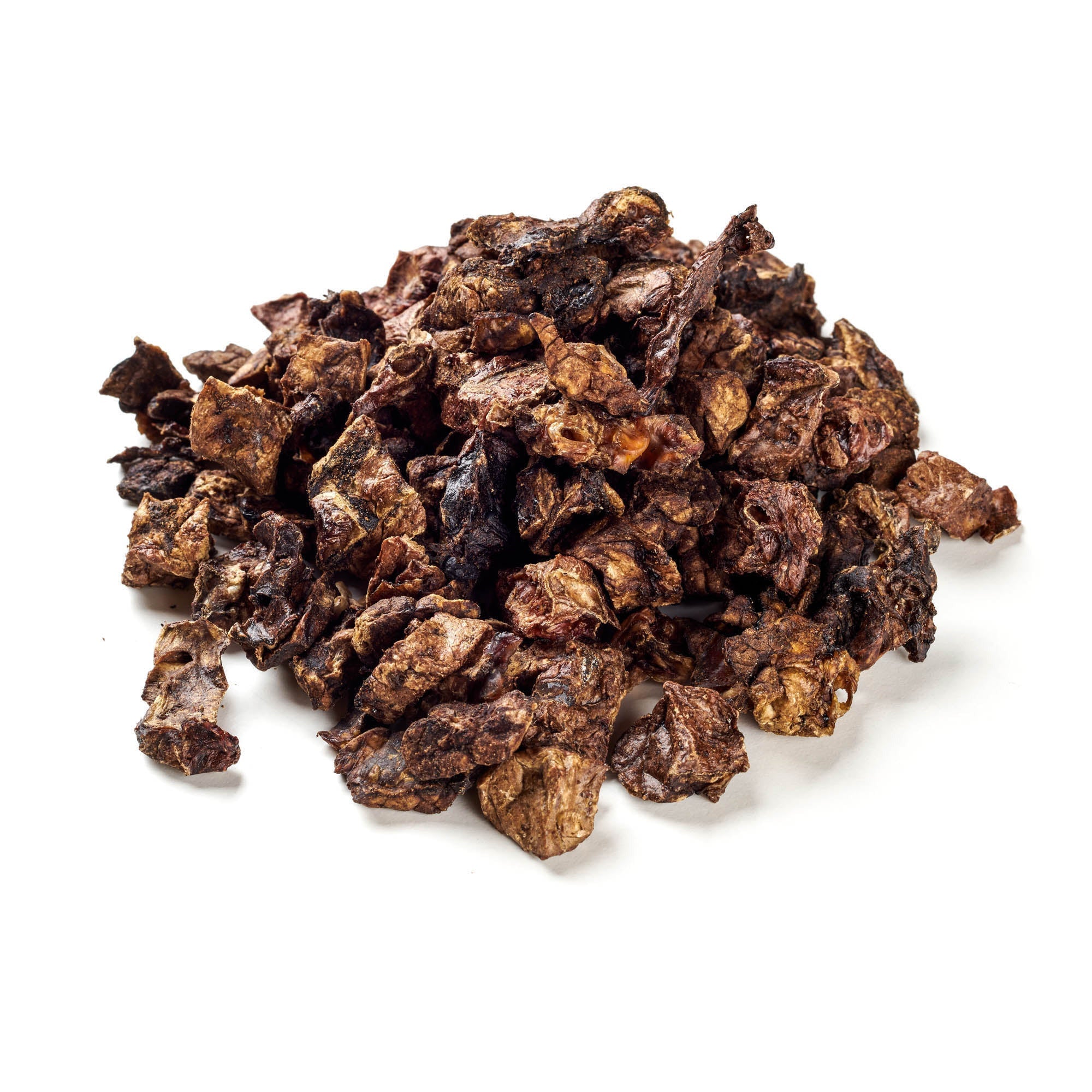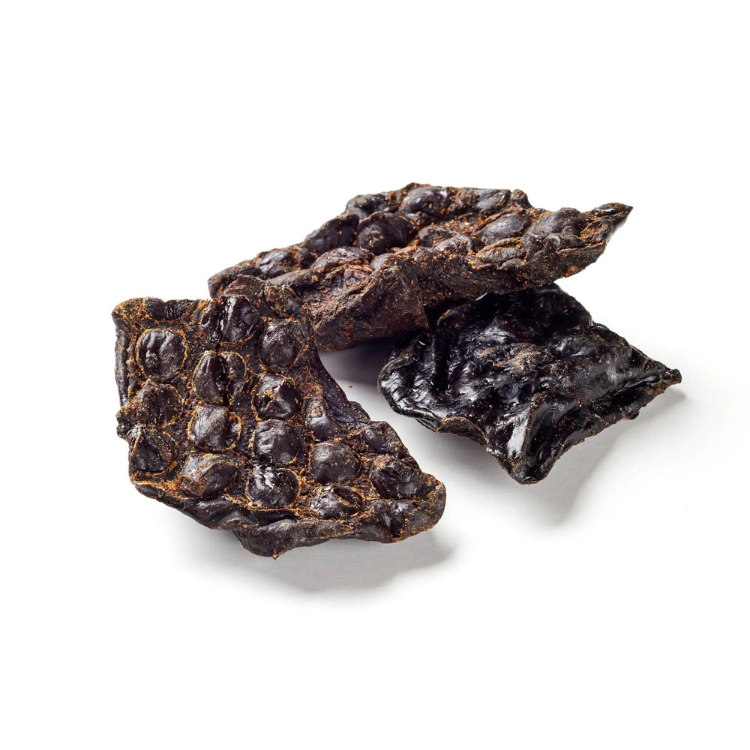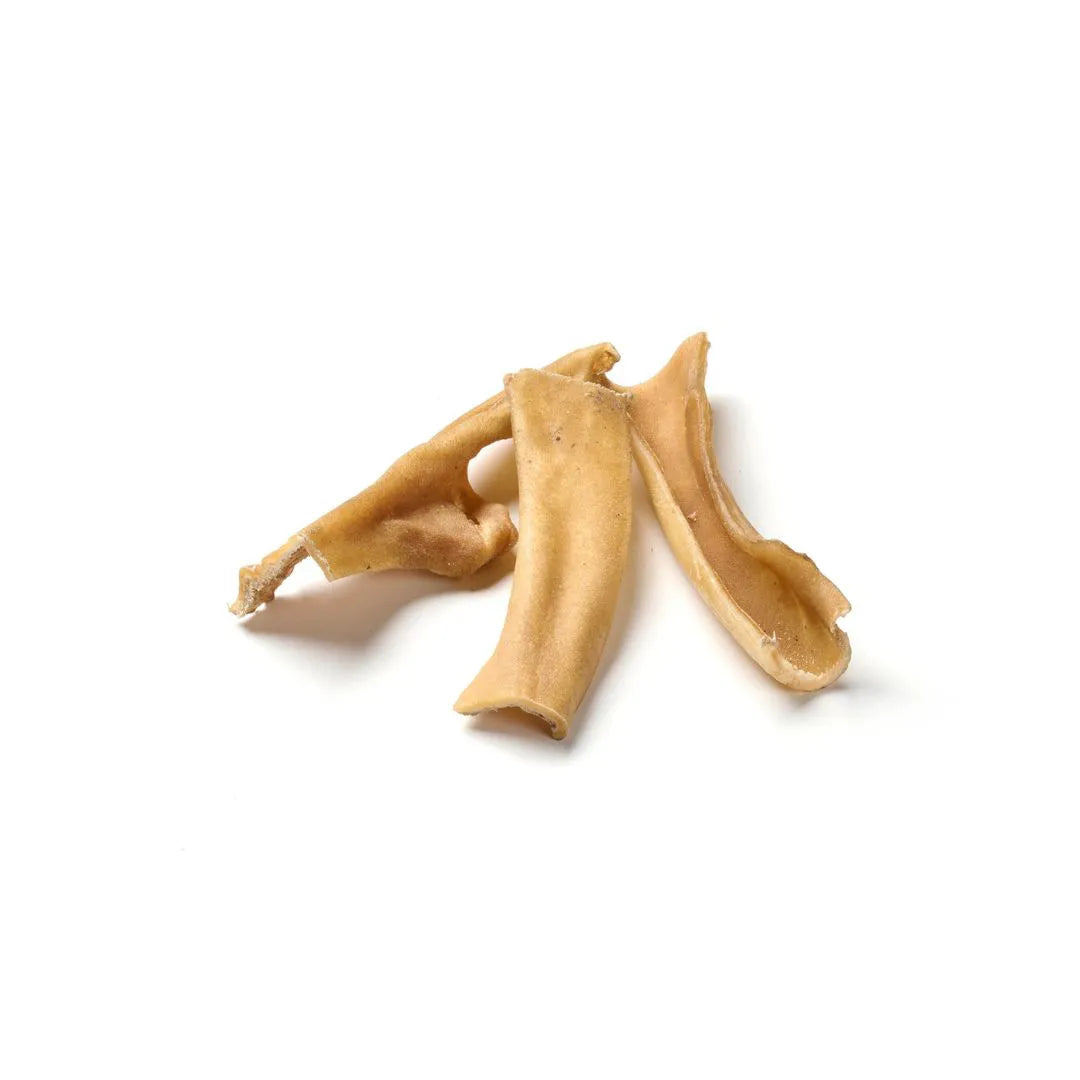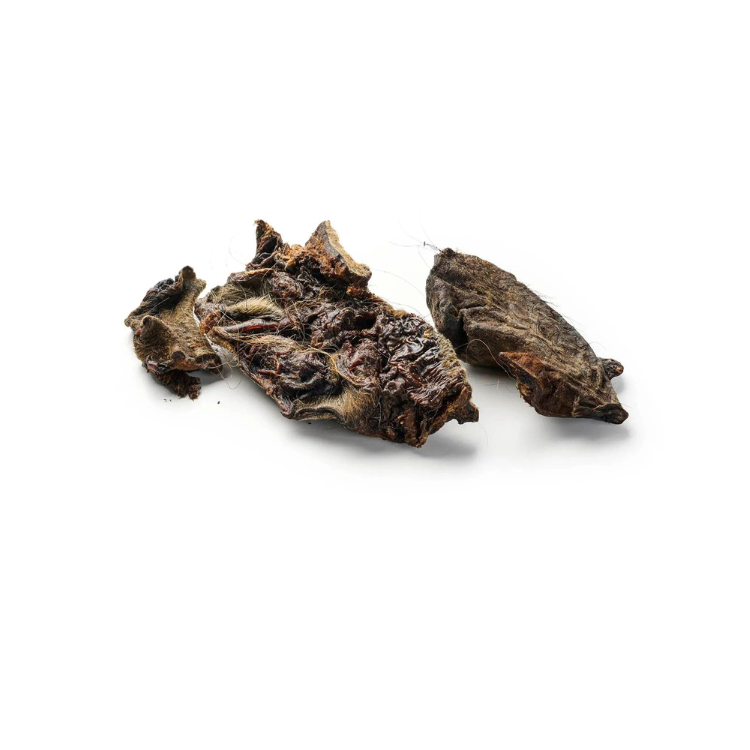
Summer thunderstorms - How to calm your anxious dog
Share
The atmosphere darkens, distant thunder rumbles and the first raindrops begin to fall - a typical summer storm is approaching. While many people enjoy the refreshing rain and the dramatic natural spectacle, our four-legged friends often experience these moments very differently. For them, the approach of a storm means a sudden, inexplicable threat accompanied by loud crashes and blinding light.
Content: Summer thunderstorms - How to calm your anxious dog
- Why are dogs afraid of thunderstorms?
- Preparing for a thunderstorm
- Acute measures during the storm
- Long-term strategies for managing anxiety
- Use of aids
- When should you seek professional help?
- Conclusion
Delicious dog snacks for pure enjoyment are available from us!
The sound of thunder, the rush of rain and the flash of lightning can be overwhelming and frightening for dogs, who have much more sensitive hearing than humans. These sudden and intense sensory impressions - much like the annual fireworks display on New Year's Eve - cause many dogs to panic and display behaviors that can range from mild discomfort to extreme fear. In the midst of such a summer storm, it becomes clear how important it is to find ways to provide dogs with security and reassurance in these stressful moments. The right strategies and preparation can help to alleviate fear and get your loyal companion through the stormy times.
Why are dogs afraid of thunderstorms?
Dogs react differently to thunderstorms, and their fears can have a variety of causes. Understanding these causes can help ease your dog's fear. Some dogs are naturally more fearful or sensitive to noise, while others react fearfully because of bad experiences in the past, such as trauma from a loud bang. Genetic factors can also contribute to a predisposition to noise anxiety.
Thunder and lightning are loud, sudden and unpredictable noises that put a lot of strain on dogs' sensitive hearing. While we humans perceive the noises as being far away, dogs often hear them much more intensely and directly. Dogs are very sensitive to atmospheric changes: the change in air pressure, the electrical tension in the air and the smells that accompany an approaching thunderstorm can worry dogs, as these changes seem inexplicable and threatening to them - while we humans hardly notice many of them.
A dog that has grown up in a quiet environment may be more easily frightened by the sudden intensity of a thunderstorm, while dogs that have had positive experiences with loud noises at a young age often show less fear of thunderstorms. During a thunderstorm, dogs may show various physical and psychological reactions, such as shaking, drooling, panting, and gastrointestinal complaints such as diarrhea or vomiting, resulting from the increased stress level and activation of the nervous system.
Dogs' behavior also changes: some dogs become destructive and scratch at furniture or doors to escape, while others stiffen up or try to make themselves as small as possible. Many dogs instinctively look for a safe place to hide during a thunderstorm - be it a dark room, a corner, or under furniture. This behavior shows the dog's strong desire to escape the perceived danger.
Some dogs run restlessly back and forth without being able to calm down, constantly switch between different hiding places or keep looking for help from their owners. Excessive barking, howling or whining are common symptoms of fear, which can be interpreted as a cry for help or an attempt to control or drive away the threatening situation. In extreme cases, fear can lead to destructive behavior: dogs scratch at doors, windows or furniture to escape, which is not only harmful to your home but can also lead to injuries to the dog.
If a dog has shown a strong fear response to a thunderstorm once, this may be more pronounced in future thunderstorms because the anticipation of the stress causes the dog to show fear at the first sign of an approaching storm. The fear of thunderstorms is similar to other noise fears, such as the fear of fireworks or loud engine noises. In all cases, dogs react to the intensity and unpredictability of the sounds, causing them stress and fear.
Similar to thunderstorms, fireworks are characterized by loud, sudden bangs and bright lights, which is why many dogs show the same fear reactions during fireworks. Some dogs also react with fear to everyday loud noises such as vacuum cleaners, hair dryers or construction site noise, which, if left untreated, can lead to generalized fear behavior. While it is possible to gradually accustom the dog to some noise fears, the unpredictability of thunderstorms remains a particular challenge. However, preventative measures such as desensitization and targeted training can help reduce fear.
High-quality dog chews for your faithful companion can be found here!
Preparing for a thunderstorm
Being prepared can help reduce your dog's anxiety during a thunderstorm. With the right measures, you can help him feel safe and secure. Check weather forecasts regularly to be prepared for upcoming thunderstorms. Many weather apps and websites provide detailed information about upcoming weather events. Early detection of an approaching thunderstorm will allow you to take action in time. Try to be home during the forecasted thunderstorm. Your presence can provide your dog with considerable comfort. If you know a thunderstorm is coming, plan your activities so that you can stay with your dog.
Close windows and doors to muffle the volume of thunder. Draw curtains or blinds to minimize flashes. These simple measures can significantly reduce the intensity of the sensory impressions your dog experiences during the storm. Set up a safe place for your dog to retreat to where he will feel comfortable and protected during the storm. This place should be quiet and away from the hustle and bustle so that your dog can feel safe and secure.
An ideal retreat may be a quiet room without windows, a cozy dog bed , or a crate that your dog already feels is safe. A room inside the house, such as a bathroom or basement, may be particularly suitable as it is more shielded from the sounds and lights of the storm. Set up the retreat with soft blankets and your dog's favorite toys.
The familiar smell and soft surroundings can be calming. Having a set place for your dog to relax can help reduce his anxiety. Make sure your dog has access to this safe space at all times, especially if a thunderstorm is forecast. He should be able to retreat there at any time if he feels uneasy.
In addition to spatial preparation, having the right equipment can also help reduce your dog's anxiety. Have natural calming agents on hand such as Bach flowers, pheromone diffusers or specially formulated treats that can help reduce your dog's anxiety.
Consult your veterinarian to find the best options for your dog. Prepare your dog's favorite toys, especially those that can keep him occupied and distracted. Chew toys or interactive toys can help distract your dog's attention from the storm and calm him down. Consider playing soothing music or white noise to mask the loud sounds of the storm. There is special music and soundscapes designed for dogs that can have a calming effect.
Acute measures during the storm
During a thunderstorm, it's important to take immediate action to ease your dog's anxiety. Use calming techniques like gentle petting or massage to show your dog that you are with him and protecting him. These physical touches can have a calming effect and reinforce feelings of security. Stroke your dog slowly and steadily, preferably in areas he particularly likes, such as the neck or chest.
These calming touches can help slow the heart rate and relax the muscles. Speak calmly and gently to your dog. Your calming tone can signal to him that there is no danger and that he can relax. Avoid speaking in a frantic or excited manner, as this could increase your dog's anxiety.
Distractions such as playing with a favorite toy or offering treats can help divert your dog's attention from the storm. Offer your dog his favorite toy to divert his attention from the frightening noises. Interactive toys that require his concentration are especially helpful. Treats or chews can be an effective distraction.
Use this opportunity to reward your dog for calm behavior and give him positive associations with the situation. If your dog likes to play, try initiating a short play session. This can help distract his mind from the loud noises of the storm and use his energy in a positive way. Your dog is picking up on your emotions. Stay calm and composed to signal to him that there is no danger.
Your calmness can help him to relax as well. Don't show any signs of stress or nervousness, as your dog will notice and react to these immediately. Your calmness can make him feel that everything is fine. Act as normal as possible and avoid over-comforting your dog, as this could confirm his fear. Your calm and confident presence can give him the security he needs. Try to carry on with your normal activities and maintain a relaxed atmosphere. This shows your dog that there is nothing to worry about and can help reduce his anxiety.
Soothing music or white noise can help mask the sounds of the storm and create a relaxing atmosphere. There is special music and soundscapes designed for dogs. Play soft, calming music to mask the sounds of thunder. There are many playlists and CDs designed specifically for dogs to help them relax.
Use white noises such as the hum of a fan or special noise machines to drown out the intense sounds of the storm. These sounds can provide a constant and calming background. There are special audio therapy programs for dogs that include soothing sounds and melodies. These can be particularly effective in reducing anxiety during a storm.
By implementing these immediate measures, you can help reduce your dog's anxiety during a thunderstorm and give him a sense of security. These techniques will not only help in the moment of the storm, but can also help your dog react less fearfully to such situations in the long term.
Treat your dog to something special with our chew products!
Long-term strategies for managing anxiety
Long-term strategies can help permanently reduce your dog's fear of thunderstorms. These methods require patience and ongoing training to help your dog manage his fear. Through desensitization and counterconditioning, you can gradually accustom your dog to the sounds of a thunderstorm and build positive associations. This requires patience and ongoing training.
Start by playing thunderstorm sounds to your dog at a very low volume while he is in a relaxed environment. Increase the volume slowly and gradually over several weeks or months while making sure your dog remains calm. This will help him gradually get used to the sounds without developing fear. Combine the thunderstorm sounds with positive experiences, such as rewards or favorite toys .
Every time your dog hears the sounds and remains calm, reward him with a training treat or a play session. This will help him develop positive associations with the previously frightening sounds. Be consistent and regular in your training. This is the key to successful desensitization and counterconditioning. It may take several months for your dog to make significant progress, but patience and consistency will pay off.
Regular training and positive reinforcement can build your dog's confidence and help him stay calmer in stressful situations. Reward calm behavior during a thunderstorm. Incorporate regular training sessions into your dog's daily routine to teach basic commands like "sit," "down," and "stay" - these can help your dog respond better in stressful situations.
A set routine and consistency in everyday life can provide security and structure for your dog. Regular feeding times, walks and playtimes can help reduce stress. Maintain regular times for feedings, walks and playtimes. A predictable routine gives your dog a sense of security and can help reduce anxiety.
Develop rituals that will give your dog security during stressful times. This could be a specific calming ritual before bedtime or a set routine before leaving the house. Try to create a constant and stable environment for your dog. Avoid frequent changes in his environment that could cause additional stress.
Use of aids
There are various remedies that can help to reduce your dog's anxiety. These remedies can help to cope with stressful situations such as thunderstorms and give your dog a sense of security. Sedatives or natural preparations such as Bach flowers or CBD oil can help your dog to relax. However, always consult a veterinarian before using such remedies.
- Bach flowers: These natural essences can help reduce your dog's stress and anxiety. There are special mixtures formulated for animals that can be administered in drop form.
- CBD oil: Cannabidiol (CBD) is known for its calming properties and can help dogs relax in stressful situations. Make sure to choose a high-quality product and check with your veterinarian about dosage.
- Homeopathic remedies: There are a variety of homeopathic remedies that can help calm dogs. These remedies should always be used under the guidance of a veterinarian to ensure proper dosage and use.
- Natural supplements: Natural supplements such as chamomile, valerian or lemon balm can also have a calming effect. These herbs can be administered in the form of teas, capsules or snacks .
- Thundershirts: These specially designed vests apply gentle, constant pressure to your dog's body, similar to a hug. This pressure can have a calming effect and reduce your dog's anxiety. They are easy to put on and come in a variety of sizes.
- Calming blankets and pillows: There are special blankets and pillows that are filled with calming materials or have a calming texture that can help your dog feel safe and secure during a thunderstorm.
- Anti-stress bandanas: Bandanas impregnated with calming scents can be tied around your dog's neck. These scents can have a relaxing effect and help calm them down.
Pheromone sprays or diffusers as well as aromatherapy with calming scents such as lavender can have a relaxing effect on your dog.
- Pheromone sprays and diffusers: These products contain synthetic versions of the calming pheromones that mother dogs give their puppies. These pheromones can be diffused in the environment to give your dog a sense of security. Pheromone sprays can be applied to your dog's favorite sleeping spots, while diffusers continuously release pheromones into the air.
- Aromatherapy: Essential oils such as lavender, chamomile and bergamot are known for their calming properties. These can be used in a diffuser or diluted and dropped onto a cloth and placed near the dog. However, keep in mind that some essential oils such as tea tree oil , peppermint oil , eucalyptus oil , cinnamon oil , citrus oil and some others can be toxic to your dog. If in doubt, please find out more about this or seek advice from a veterinarian!
- Calming scented candles: There are special scented candles for pets that contain calming essential oils. These candles can create a relaxing atmosphere and help relieve your dog's anxiety.
By using these tools, you can help reduce your dog's fear of thunderstorms and help him feel safer and more secure. It's important to try different methods and see which ones work best for your dog.
When should you seek professional help?
Sometimes professional help is needed to manage your dog's anxiety. In severe cases, support from veterinarians and behavior therapists can be crucial to improving your dog's well-being. If your dog is displaying extreme anxiety reactions that are significantly affecting his well-being, it is advisable to seek professional help.
These signs include uncontrollable shaking, panic attacks, or self-harm. If your dog shakes violently and uncontrollably every time there is a thunderstorm, this indicates serious anxiety that can greatly affect his quality of life. This is a clear indication that he needs professional help. Panic attacks are a sign of extreme anxiety.
Symptoms may include heavy panting, restless pacing, aimless jumping, or desperate barking. Such reactions require immediate and professional intervention. In extreme cases, dogs may try to injure themselves by chewing or scratching their skin. This behavior is a clear sign that your dog's anxiety is out of control and he needs urgent help.
A veterinarian can offer medical solutions, while a behavior therapist can use special training methods to reduce your dog's anxiety. Veterinarians can prescribe special sedatives or anti-anxiety medications that help reduce the symptoms of anxiety. These medications may be necessary in particularly severe cases to provide your dog with short-term relief. A behavior therapist can help your dog by using special techniques to manage anxiety and stress.
These include desensitization, counterconditioning, and other training methods aimed at changing your dog's responses to thunderstorms. Both the veterinarian and behaviorist will regularly monitor your dog's progress and adjust treatment strategies accordingly. This will ensure that interventions are effective and address your dog's specific needs.
A therapist who specializes in animal behavior can develop customized strategies to manage your dog's anxiety. Behavioral therapy can help reduce your dog's anxiety in the long term. A behavior therapist will create an individualized treatment plan tailored to your dog's specific fears and behaviors.
This may include a combination of training, desensitization, and positive reinforcement. Behavioral therapy aims to create long-term changes in your dog's behavior. With ongoing training and support, your dog can learn to better manage his fear and feel more confident in stressful situations.
Behavior therapists work closely with dog owners to ensure they understand and can use the techniques and strategies. This collaboration is crucial to the success of the therapy. In particularly severe cases, it may be helpful to see an animal anxiety specialist. These experts have extensive experience in dealing with extremely anxious dogs and can offer specialized treatment plans.
Professional help can be crucial to effectively managing your dog's fear of thunderstorms. By combining veterinary care, behavior therapy, and specialized treatment strategies, your dog can learn to overcome his fear and live a more relaxed life.
Conclusion
Dealing with an anxious dog during a summer thunderstorm can be challenging, but with the right measures and patience, you can help your dog overcome his fear. By recognizing and understanding the signs of his fear, you can respond to them and provide the support he needs. Preparing for a thunderstorm, such as creating a safe place to retreat to and providing calming tools, can ease your dog's immediate anxiety. Acute measures during the storm, such as calming techniques, distractions, and maintaining your own calm, are also crucial. Long-term strategies, such as desensitization, positive reinforcement, and maintaining a stable routine, can help reduce your dog's anxiety in the long term.
By applying these methods, your dog will learn to feel more secure in stressful situations and to better manage his fears. Your care and support are essential and will help your dog to live a happier and more relaxed life.
Delicious dog snacks for pure enjoyment are available from us!





